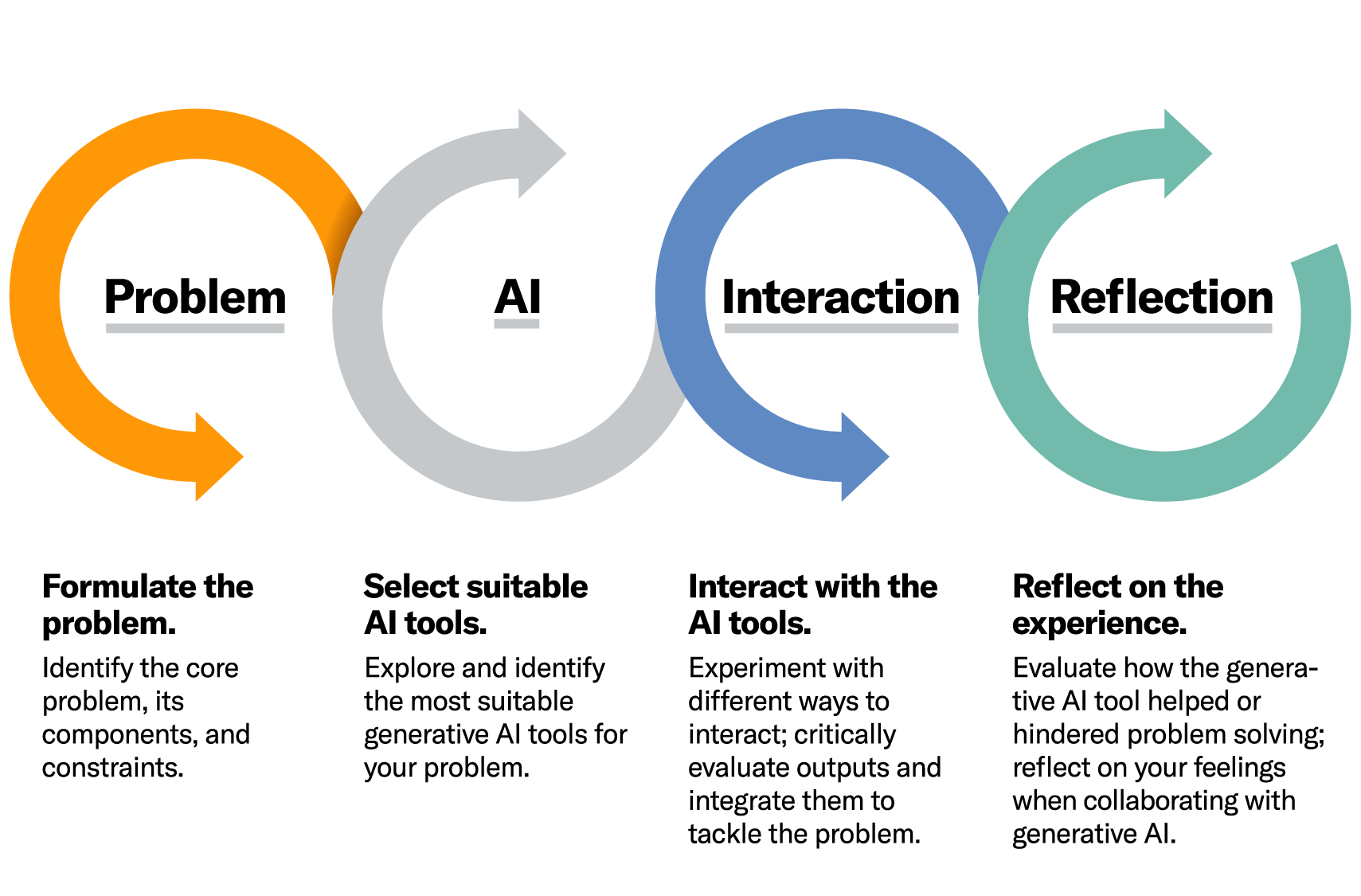There are numerous online courses and documents available to help you gain a comprehensive understanding of Generative AI, covering its usage and development, enabling users to become experts in the field.

Best Roadmap to Learn Generative AI in 2024 by Analytics Vidhya
Professor Oguz A. Acar from King’s College London has defined five key skills students need to effectively use generative AI and has also developed the PAIR (Problem, AI, Interaction, Reflection) framework to cultivate these skills, based on his research around the psychology of AI and student learning.
Five Key Skills Students Need to Harness Generative AI
- Problem formulation is the thinking you do before you attempt to prompt the AI; it’s outlining the focus, scope, and boundaries of a problem. Simply put, without a deep understanding of the problem to be solved, your prompts won’t be effective—no matter how well they’re phrased for AI.
- Exploration. With so many new AI products emerging every week, it is increasingly important and difficult to identify the most suitable tool for the task at hand. To be able to do this, students must be familiar with major generative AI tools such as ChatGPT and Stable Diffusion, and remain motivated and curious to keep up with whatever generative AI tools and enhancements are coming next.
-
Experimentation. Given the ever-evolving nature of these tools, one effective way to keep up is to just continue experimenting with them. Experimentation involves a hands-on interaction with the AI, a process of trial and error, and an assessment of the outcomes.
-
Critical thinking. Generative AI tools sometimes produce inaccurate or biased content—arguably their greatest limitation. Critical thinking helps identify and mitigate this limitation. It’s about applying a disciplined, objective lens to evaluate the information or arguments generated, which also deepens students’ learning.
-
Willingness to reflect. Engaging with generative AI systems can sometimes stir emotions, particularly when the tools are used for tasks closely tied to one’s identity or self-worth. Adopting a reflective practice can help students understand these emotional reactions. Although it shares certain elements with critical thinking, reflection focuses on examining one’s personal thoughts, feelings, beliefs, and actions, as opposed to the AI’s output.
A Framework to Develop These Key Generative AI Skills: PAIR
- Problem formulation: Students define the problem or challenge they want to solve.
-
AI tool selection: Students choose the best generative AI tools to help them with their problem. They learn how to explore, compare, and evaluate different generative AI tools and their features.
-
Interaction: Students use the generative AI tools to solve their problem. They experiment with different inputs and outputs and see how the generative AI tools affect their problem-solving process and outcome.
-
Reflection: Students assess and report their experiences with the generative AI tools

For further information and case regarding PAIR, please refer to the following page:
Open Courses for Generative AI
-
Learn with Baker Library: Generative AI for MBAsThis module is designed to guide learners in effectively and responsibly utilizing generative artificial intelligence tools to enhance learning experience at HBS, including: Guidance and best practices on using generative AI tools for research; Harvard University and HBS guidelines; Use cases for MBA students.
-
Generative AI for Everyone ( Andrew Ng on Coursera)It includes hands-on exercises where you'll learn to use generative AI to help in day-to-day work and receive tips on effective prompt engineering.
-
Prompt Engineering for ChatGPT ( Jules White on Coursera)This course introduces students to the patterns and approaches for writing effective prompts for large language models.
-
Introduction to Generative AI ( Google on Coursera)This is an introductory level microlearning course aimed at explaining what Generative AI is, how it is used, and how it differs from traditional machine learning.
-
Introduction to Generative AI Learning Path (Google)This learning path provides an overview of generative AI concepts, from the fundamentals of large language models to responsible AI principles.
-
Generative AI for Developers Learning PathA Generative AI Learning Path with a technical focus, built for App Developers, ML Engineers, and Data Scientists. Recommended prerequisite: Introduction to Generative AI learning path.
Open Platforms and Frameworks for Generative AI
-
GithubGitHub is the world's leading AI-powered developer platform, where companies and developers come together to collaborate, share projects, and exchange code. It serves as a hub for a multitude of AI-related projects, software, and source code, making it a valuable resource for the global developer community.
-
Hugging FaceHost and collaborate on unlimited models, datasets and applications. Also courses can be found.
-
LangChainLangChain’s flexible abstractions and AI-first toolkit make it the #1 choice for developers when building with GenAI.
-
LlamaIndex
 LlamaIndex is the leading data framework for building LLM applications.
LlamaIndex is the leading data framework for building LLM applications. -
Ollama
 Get up and running with large language models locally.
Get up and running with large language models locally. -
fast.aiFast.ai is a platform dedicated to democratizing deep learning and making it more accessible to a wider audience. They achieve this through various initiatives, including free courses, software library, books and community.
